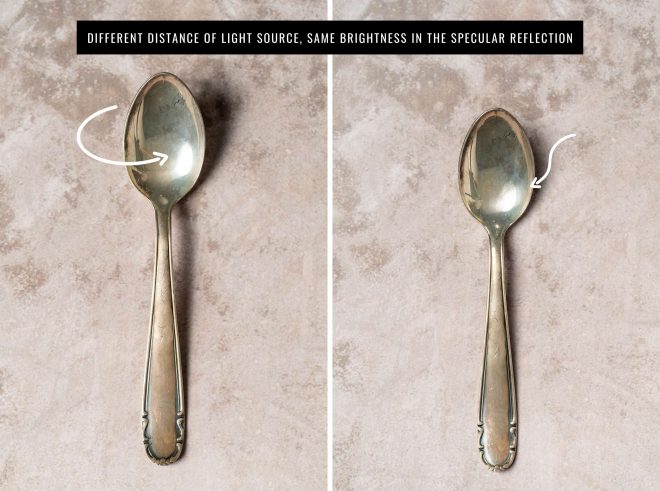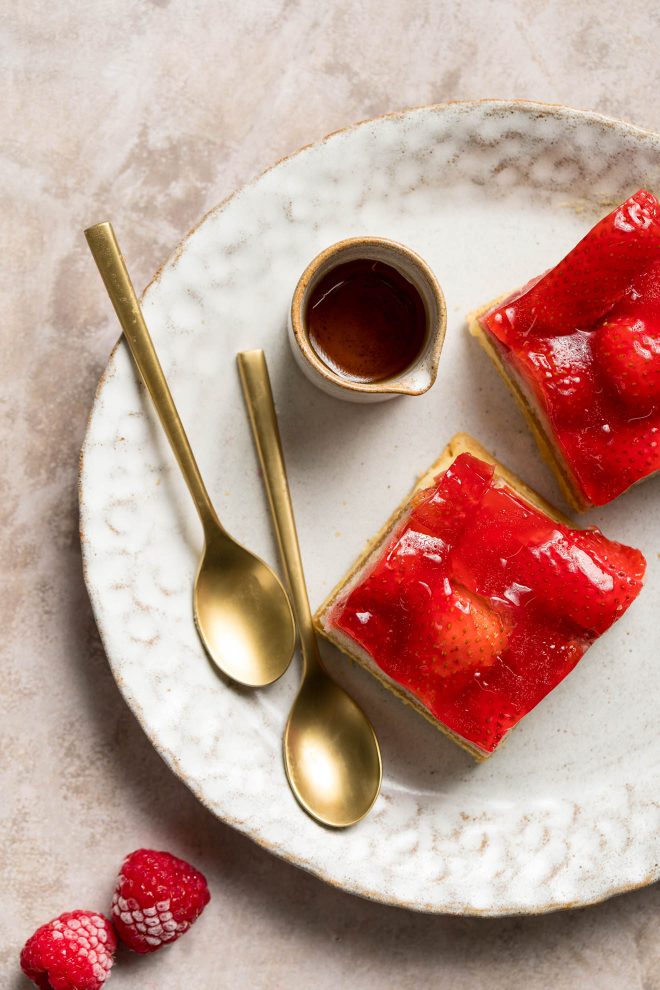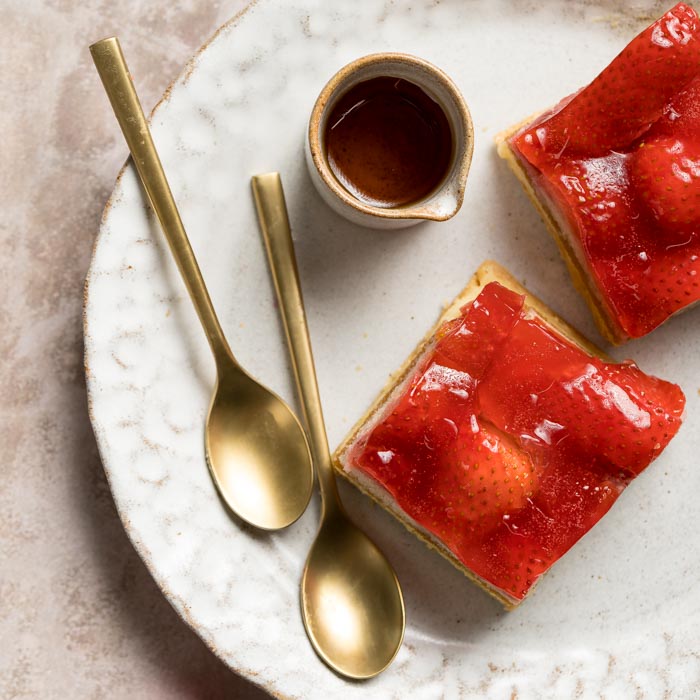Cutlery and kitchen utensils make for fantastic food photography props. But as with any shiny object, photographing silverware can be quite a challenge for food photographers. Silverware featuring crude specular reflections will totally ruin an otherwise great shot. If you’ve already found this out the hard way, you’ve likely steered clear of the cutlery drawer ever since.

But there are only so many times you can put off using silverware in favour of less reflective props. Sooner or later you’ll need to shoot a dish alongside a knife and fork. Or worse still, the dreaded spoon!
Fear not, this post explaining how to photograph cutlery, sans ugly reflections, will guarantee that you’re ready to take on any shape and form of kitchen implement a stylist or client might throw at you.
Good vs Bad Reflections
Within the context of photographing silverware and other shiny props, there are effectively two different kinds of reflection we need to concern ourselves with. One presents no particular challenge for us as photographers, the other is, quite frankly, a nightmare.
● Specular Reflections
Specular reflections (also known as direct reflections) occur on shiny surfaces. Here light hits the surface of the subject you are photographing and bounces directly into your camera lens. These reflections are particularly difficult to tame and we’ll be looking at them more closely in a minute.
● Diffuse Reflections
With diffuse reflections, the light doesn’t rebound straight off the surface and into the camera but instead bounces around everywhere. As here the light is reflected equally in all directions, it appears the same brightness regardless of the angle it is viewed from. In essence, if you were to walk around an object that produces diffuse reflections, photographing it from all sides using the same settings for each shot, the subject would appear equally bright in every photo.
Be My Mirror
Move a light closer to a subject that produces diffuse reflections and the subject will appear brighter. Move the light further away and it will appear darker. This seems pretty obvious, right?
But try doing the same thing with a light that’s shining on a specular surface and you’ll see no change in the brightness of those reflections whatsoever. If this seems odd, remember that the original meaning of the word specular is “mirror-like.” And if you were to look at an ordinary table lamp reflected in a mirror, you wouldn’t expect its output to increase or decrease in power just because it was moved from one part of the room to another.
Specular reflections on silverware and utensils are no different from reflections in a mirror: the bright ugly bleached-out areas you see on photographed silverware are direct reflections of the light source. So if, rather than photographing a chopping knife or a steel serving spoon, you were to instead photograph a mirror, the effect would be exactly the same; bright light reflected down the lens.

The Family of Angles
But as you will already know from looking in a mirror, if you can’t see the reflection of a light source itself – for example the table lamp mentioned above – you won’t see a huge amount of the light it produces either; likely no more than just a warm glow on the walls. But change position so that you can see the table lamp directly reflected in the mirror, and the light will shine right into your eyes and may be uncomfortably bright.
Returning to our example of walking around a subject shooting it from all sides, if the subject is changed to one that produces specular reflections, the effect will be very different from photographing a subject that produces diffuse reflections. With diffuse reflections, all our photos depicted an identically-bright subject, no matter which position they were shot from. But with specular reflections, depending on our position in relation to the subject, some photos will show the light source brightly reflected in the surface of the subject itself, while those taken from other positions may not show a great deal of anything at all.
The range of positions in which a camera will be able to see direct specular reflections of a light source in the surface of a subject is known as the family of angles. The family of angles will vary depending on:
● The position of both the subject and the light source in relation to the camera.
● The focal length of the lens you use to take the photograph.
There are some really helpful diagrams in chapter 3 of Light, Science, and Magic, to help you understand how the family of angles works. This is one of my most highly recommended books all food photographers should read!
The Solution
Light will bounce off a surface at the same angle in which it hit that surface. This makes it easy to predict whether you are setting up your lights in a position that will cause specular reflections or not. Simply put, if the subject were an actual mirror, and you stood in the position of the camera, would you be able to see the light source in the mirror? If so, your camera will also see the light source reflected in the subject.
This problem is easily fixed by moving either the camera or the light source so that their family of angles no longer coincide. Also bear in mind that the wider the lens you use, the wider the family of angles. So if you are struggling to position your light source outside the family of angles, switching to a longer focal length lens may solve the problem.
Related: Putting Together a Home Food Photography Studio, Pt. 3: Lighting Equipment
How to Photograph Silverware Without Tearing Your Hair Out
Although I’ve tried to keep things very simple, I realise that the above description of the family of angles might be a bit toooooo technical. However, there is actually a much easier solution to the problem of unwanted reflections on silverware than moving your camera and lights around.
Not only this, but it’s important not to lose sight of the fact that as food photographers our number one responsibility is always to the food. Props and other elements come much further down our list of priorities. This means that you are never going to walk into a studio and start setting up your lights expressly for the silverware. Instead you light to make the food look amazing, and only then will you worry about whether your props look good or not. If you start moving lights around in order to avoid specular reflections on the props, you’re likely to ruin whatever great lighting setup you had going on for the food.
Tip number 1: If you’ve understood the part above explaining how specular reflections in part depend upon the position of the subject in relation to the camera, you’ve understood enough to see an easy way out of this predicament; position the lights for the food, yes, but position the silverware for the lights.
Tip number 2: Another trick is to place a small prop underneath a spoon, such as a small piece of blutack, which effectively tilts the spoon away from the light source, just outside the family of angles, eliminating the reflection, without our viewer ever knowing the difference.
Tip number 3: Switch your cutlery. It might sound obvious, but don’t make your life harder by using ultra reflective utensils, spend some time looking for more matte/rustic/vintage pieces, which will already help produce diffuse reflections instead of specular ones. These gold teaspoons I found at H&M home are perfect for this! They give a nice amount of shine, allowing them to sill look 3D and not flat, but don’t create those hard, direct specular reflections.

Have you found some new tricks to try to help you master avoiding those pesky reflections?

This is very good info, but what if your subject is actually the Flatware? And said flatware is insanely reflective collectors items, actually as good as mirrors. And in your photos, you need to emphasize the mirror quality without you or your camera becoming the reflection in the photo.
If you need the subject to be the flatware, then it might be worth investing in some anti glare spray, and playing around with the position of your light based on the family of angles.
I love that it is a slightly ‘technical’ for a bit of understanding of specular and diffuse. The solutions are obvious but I’m glad to have read it before getting frustrated with shiny cutlery. Years ago I was asked to shoot trophies, silver trophies. No way could I get my reflection out! The light was manageable. that experience has scared me off shiny ever since. Thank you for this Lauren.
You’re so welcome Anne, glad you found it helpful
Very helpful . Thank you ever so much
You’re so welcome Souad! Glad you enjoyed the tips!
This was very helpful. Thank you for explaining it.
You’re welcome Maria! So glad you found it useful!